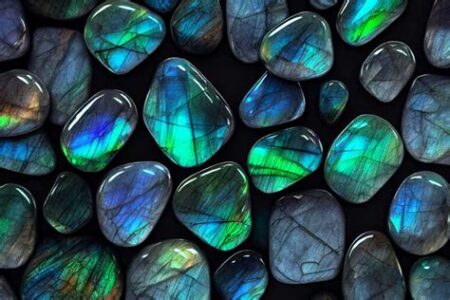Pyrite, commonly known as “fool’s gold,” is an abundant mineral with a metallic luster that has captivated humans for centuries. While it may not be as valuable as gold, pyrite holds a unique place in various industries and applications, from jewelry making to health and wellness. This comprehensive guide will delve into the many uses of pyrite, its purported benefits, and its potential new applications.

Properties of Pyrite
Pyrite is an iron sulfide mineral with the chemical formula FeS2. It crystallizes in the cubic system and often forms octahedral or pyritohedral crystals. Pyrite is a hard mineral with a Mohs hardness of 6-6.5, making it less resistant to scratching than quartz but harder than many other minerals. The striking golden-yellow color of pyrite is due to the presence of iron and sulfur atoms.
Uses of Pyrite
Pyrite has been used for various purposes throughout history:
Jewelry and Decoration
Pyrite is often used in jewelry making, creating striking pieces with its golden luster. It can be incorporated into necklaces, earrings, bracelets, and rings, adding a touch of metallic flair to any outfit.
Metallurgy
Pyrite is an important source of iron. The mineral is heated in the presence of oxygen, releasing the iron content for use in steel production and other metallurgical applications.
Electronics
Pyrite has unique electrical properties that make it useful in certain electronic devices. Specifically, the mineral can be used as a semiconductor in transistors and other electronic components.
Health and Wellness
Despite limited scientific evidence, pyrite has been used in traditional and alternative medicine for its purported healing properties. It is believed to have anti-inflammatory, antioxidant, and blood-purifying effects. Some practitioners also claim that pyrite can alleviate fatigue, improve sleep, and boost energy levels.
Benefits of Pyrite
Although scientific evidence is lacking, some proponents of pyrite use claim the mineral offers several benefits, including:
- Emotional Balance: Pyrite is believed to promote emotional balance and stability.
- Stress Relief: Some claim that pyrite can reduce stress and anxiety.
- Improved Sleep: Pyrite is thought to aid in restful sleep.
- Boosted Energy: Proponents suggest that pyrite can invigorate and provide an energy boost.
- Pain Relief: Pyrite is believed to have anti-inflammatory properties that may alleviate pain and discomfort.
Pros and Cons of Pyrite
Pros:
- Eye-catching golden luster
- Durable and long-lasting
- Relatively inexpensive
- Purported health benefits
Cons:
- Can tarnish over time
- Susceptible to scratching
- Limited scientific evidence supporting its purported benefits
Potential New Applications for Pyrite
Emerging research and technological advancements are uncovering promising new applications for pyrite:
- Hydrogen Production: Pyrite can be used as a catalyst in the production of hydrogen, a clean energy source.
- Solar Energy Conversion: Pyrite-based materials show potential for improved efficiency in solar cells.
- Biotech Engineering: Pyrite can be employed as a novel material for biosensors and other biomedical devices.
Tables for Easy Reference
Table 1: Properties of Pyrite
| Property | Value |
|---|---|
| Chemical Formula | FeS2 |
| Crystal System | Cubic |
| Mohs Hardness | 6-6.5 |
| Color | Golden-yellow |
Table 2: Uses of Pyrite
| Industry | Application |
|---|---|
| Jewelry | Ornamentation |
| Metallurgy | Source of iron |
| Electronics | Semiconductor |
| Health and Wellness | Purported healing properties |
Table 3: Purported Benefits of Pyrite
| Area | Benefit |
|---|---|
| Emotional | Balance, stability |
| Physiological | Stress relief, improved sleep, boosted energy, pain relief |
Table 4: Potential New Applications for Pyrite
| Field | Application |
|---|---|
| Energy | Hydrogen production, solar energy conversion |
| Medicine | Biosensors, biomedical devices |
Frequently Asked Questions (FAQs)
1. Is pyrite toxic?
Pyrite is generally considered non-toxic when handled properly. However, grinding or heating pyrite can produce sulfur dioxide gas, which can be harmful if inhaled.
2. Can pyrite really heal?
While pyrite has been used in traditional medicine for centuries, there is limited scientific evidence to support its purported healing properties.
3. How can I use pyrite for jewelry making?
Pyrite can be cut and set into jewelry pieces, such as pendants, earrings, and rings. Its golden luster complements various metals, including gold, silver, and copper.
4. How can pyrite be used in electronics?
Pyrite’s electrical properties make it suitable for use as a semiconductor in certain electronic devices, including transistors and other components.
5. What are the potential risks of using pyrite?
Pyrite can tarnish over time and is susceptible to scratching. Grinding or heating the mineral can release sulfur dioxide gas, which can be hazardous if inhaled.
6. How can I care for pyrite jewelry?
To maintain the luster of pyrite jewelry, avoid exposing it to harsh chemicals or abrasives. Clean it gently with a soft cloth and warm soapy water.
7. Can pyrite help improve my health?
While some believe in the healing properties of pyrite, there is limited scientific evidence to support these claims.
8. What are some innovative applications for pyrite?
Emerging research explores pyrite’s potential in hydrogen production, solar energy conversion, and biomedical engineering.
Conclusion
Pyrite, despite its deceiving appearance, holds a place of significance in various industries and applications. Its golden luster, durability, and potential health benefits have made it a sought-after material for jewelry, metallurgy, electronics, and even health and wellness. With ongoing research and technological advancements, pyrite continues to reveal its versatility and potential for innovative applications. While its healing properties remain a subject of debate, the mineral’s aesthetic appeal and industrial significance remain undeniable.




























